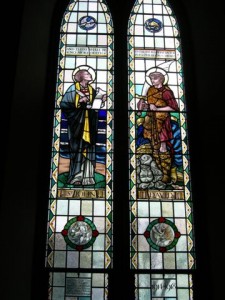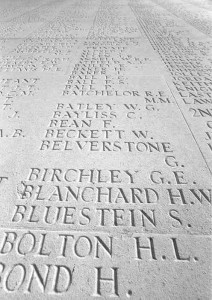They Shall Not Grow Old
 In the south wall of the church is a memorial window. It commemorates six church members who were killed during the First World War. The window only dates from 1955, when the church was rebuilt following its near destruction during the Second World War. The bomb that almost destroyed the church in 1940 also demolished the stone memorial to these six men.
In the south wall of the church is a memorial window. It commemorates six church members who were killed during the First World War. The window only dates from 1955, when the church was rebuilt following its near destruction during the Second World War. The bomb that almost destroyed the church in 1940 also demolished the stone memorial to these six men.
From its foundation in 1869, the Robinsons were one of the leading families in the church, beginning with E. S. Robinson, who had been the prime mover in the establishment of the church, right down to the death of Katherine Robinson in 1985. In the early 20th century two Robinson brothers, Edward and Kossuth, were the most prominent members of the family. Both had sons serving in the army during the War, and so it was a supreme irony that Edward’s sons survived, while Kossuth’s three sons were all killed. They are commemorated in the window.
It was also a tragic coincidence that two of Kossuth‘s sons, Geoffrey and Edward, were killed on successive days in September 1915, in different places. Geoffrey, a 2nd Lieutenant in the Gloucester Regiment was killed on 25 September at Hulluch; Edward, a 2nd Lieutenant in the Somerset Light Infantry, was killed the next day at Loos. Ten weeks later, on 8 December, the eldest brother, Clifford, was killed in Gallipoli.
The first Tyndale member to enlist following the outbreak of war, was Arnold Kerry – the secretary of the Young People‘s Guild. He had first joined the Grenadier Guards, but was then commissioned in the Devonshire Regiment. Later he transferred to the Manchester Regiment and was Mentioned in Despatches – just “one down” from a gallantry medal. The incident which led to this award, in 1916, also saw him severely wounded and sent back to England. Here he spent time in hospital before being sent as an Instructor to Cambridge. However, it appears that he had not fully recovered and he was admitted to hospital again, where he died in February 1918.
Alfred Whitewright was a member of a prominent missionary family. He had been in China immediately before the War. In 1915 he was commissioned in the Notts and Derby Regiment. What led to his death is not clear, but he died very suddenly, back in England, in June 1916.
Cyril Prewett had been an apprentice upholsterer before he joined the army in 1917. Unlike the others commemorated in the window, he was not an officer, but a Private, in the Wiltshire Regiment. He was serving as the Commanding Officer’s batman and orderly when he was killed outright by a bullet to the head after only being at the front for a few weeks. In 1914 he had married and so left a widow and also a daughter who was born a few months before he was killed. His sister married William Hockey, and through her he is linked to a family that has been prominent in the church right down to the present day.
 As well as these six church members, there were another five soldiers killed during the War, who were closely associated with the church. The Tyndale Messenger faithfully reported the deaths of those connected with the church. In October 1914 the death of C. E. Stewart of the Naval Brigade was reported following his interment in Holland. He had been a member of the Naval Brigade – sailors sent to serve with the army at the front. In September 1916 the death of Rex Kerry was reported, but I have been unable to discover anything about him or his link to the church. In 1917 Kenneth Leonard, a former bank clerk, was killed and a few weeks later Francis Tratman, a 20-year-old former Sunday School scholar, was killed. A few months before the end of the war, in May 1918, Kenneth Jenkins died from the injuries he received in a battle on the Somme. A fuller account of his life and death was published in the June/July edition of The Link.
As well as these six church members, there were another five soldiers killed during the War, who were closely associated with the church. The Tyndale Messenger faithfully reported the deaths of those connected with the church. In October 1914 the death of C. E. Stewart of the Naval Brigade was reported following his interment in Holland. He had been a member of the Naval Brigade – sailors sent to serve with the army at the front. In September 1916 the death of Rex Kerry was reported, but I have been unable to discover anything about him or his link to the church. In 1917 Kenneth Leonard, a former bank clerk, was killed and a few weeks later Francis Tratman, a 20-year-old former Sunday School scholar, was killed. A few months before the end of the war, in May 1918, Kenneth Jenkins died from the injuries he received in a battle on the Somme. A fuller account of his life and death was published in the June/July edition of The Link.
When we stand to observe the two-minute silence on Remembrance Sunday, perhaps we can bring to mind these names of men who died before any of us was born.
David T. Roberts


